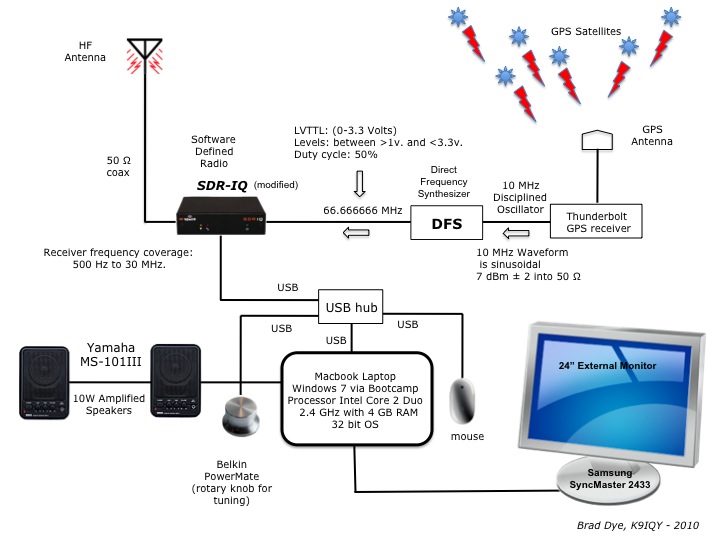
K9IQY GPS-DO Project Page My latest project is a general coverage radio receiver, tuning from audio frequencies to 30 MHz in one Hertz steps — locked to the GPS constellation. The “dial” is a I have been involved with many kinds of radio receivers for over sixty years — amateur, military, and commercial. I got my ham ticket at 15 years old. In the US Navy I was a radioman specializing in HF receivers. Later worked for Motorola in field service, then sales and engineering management. When I was a young ham, I dreamed of the day when I might have a receiver that would read out to one kilocycle (before we used the term Hertz). Only the Collins equipment would do that back then but they were for people who drove Cadillacs. Now I have assembled one that reads out to one Hertz and is stable to within ±70 µHertz — and thanks to GPS — it will maintain this accuracy as long as the GPS satellites keep working. I well remember the early tube radios that I used. I had to be very careful to not bump the table where the radio was sitting or it would jump completely off frequency. Whatever frequency it indicated was only approximate. It made me nervous to operate near a band edge. It was nice of the US government to spend billions of dollars just to keep my new radio on frequency with GPS. (ha ha) |

DFS = Direct Frequency Synthesis. This is a method of frequency generation which relies on multiplication, division and mixing, with no “locked loops” to generate noise or go out of lock. It also has the advantage that the only oscillator required is at 10 MHz, where high quality oscillators with low phase noise are readily available — like the Trimble Thunderbolt GPS-DO (disciplined oscillator) that I used. My DFS was designed and built for me by Dave Powis, G4HUP. I really appreciate his help on this project, especially since several hams told me it couldn't or shouldn't be done. Some said that the frequency read-out on the SDR-IQ would not be accurate because the time-base in the computer's sound card would be a variable factor, but this is not true. The frequency accuracy and stability of this radio ONLY depends on the 10 MHz oscillator in the Trimble Thunderbolt and that oscillator is locked to the GPS constellation. Please check out Dave's web site for more information on the DFS and the various ham radios it can be used with. Dave and I worked together on this project for about one year. The DFS box traveled across the Atlantic Ocean five times before we finished. Dave has written an excellent article about this project. You can read it here. Update from Dave Powis, G4HUP, September 8, 2010. Consulting the Trimble Thunderbolt spec (http://www.trimble.com/products/pdf/thunder.pdf), the stated accuracy of the 10 MHz output is 1.16 x 10E-12 [or 1.16 x 10-12] averaged over 1 day. In other words, the 10 MHz output remains within ± 10 µHz (yes, that's 10 micro Hertz) of the nominal frequency over the period. Since the 66.667 MHz DFS multiplies the 10 MHz signal to produce its output, you can multiply that 'error' by 7 (the main multiplier goes to 70 MHz), giving you ±70 µHz error in your clock signal to the SDR-IQ. Remember, this is a worst case figure.
And this from Pieter Ibelings, N4IP at RFSPACE : The NCO in the AD6620 is 32 bits. At 66.666666 MHz the tuning resolution is 0.015 Hz. So The accuracy of the SDR-IQ is about 0.015 Hz when running at 66.666666 MHz. The Thunderbolt will be much better than that. On Thunderbolt performance:
[source] — Tom Van Baak |
A Short Refresher On Multiples Of HertzSI multiples for hertz (Hz)
(SI=The International System of Units.) Source of the Table: |
||||||||||||||||||||||||||||||||||||||||||||||||||||||||||||||||||||||||||||||||
More info from RFSPACE: From: RFSPACE <rfspace@gmail.com> Hi Brad, Thanks for the detailed e-mail. You are correct that the soundcard clock has absolutely nothing to do with the accuracy of the SDR-IQ. It all depends on the clock driving the ADC. For those that might be interested in the absolute cheapest GPS locked 66.666000 MHz clock, here is a part from analog devices that looks really interesting. It requires no microprocessor to program since it is pin programmed. It will generate a 66.666000 MHz clock out of a 10 MHz signal in one step and it is priced at $11 from Digikey or Analog Devices. There is also an eval board available. http://www.analog.com/static/imported-files/data_sheets/AD9552.pdf It generates a 66.666000 MHz signal so you would have to enter this frequency in the calibration screen. The phase noise is not stellar, but should work fine for amateur radio. Pieter |
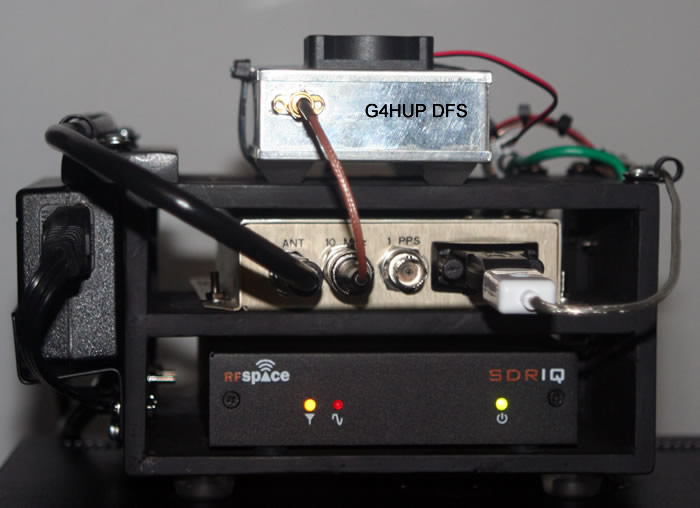
Almost Finished project — June 2010 The G4HUP DFS is in the silver box, the Trimble Thunderbolt GPS-DO is in the gold box, and the RF SPACE SDR-IQ is in the black box. The fan was added to the DFS to make a COOL project even cooler. Actually it quickly lowers the internal temperature of the DFS box by 20º C. The black-plastic power supply is on the left side of the black wooden enclosure that I made to hold it all. You can see the wiring and interconnect block in the side-view photo below. |
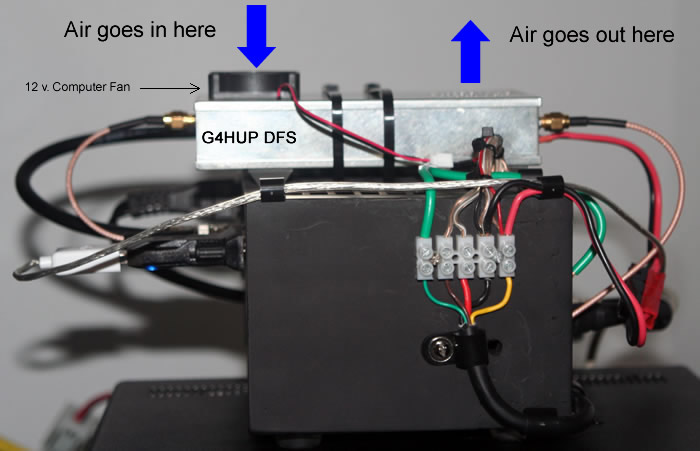

Project Upgrade December 2011
G4HUP Distribution Amplifier added
New Rack & Power-connector Block
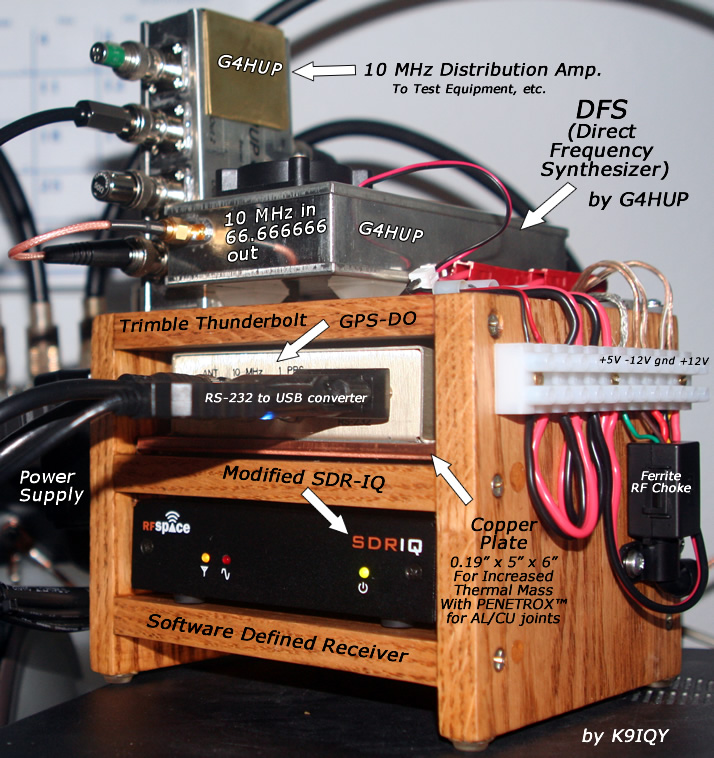
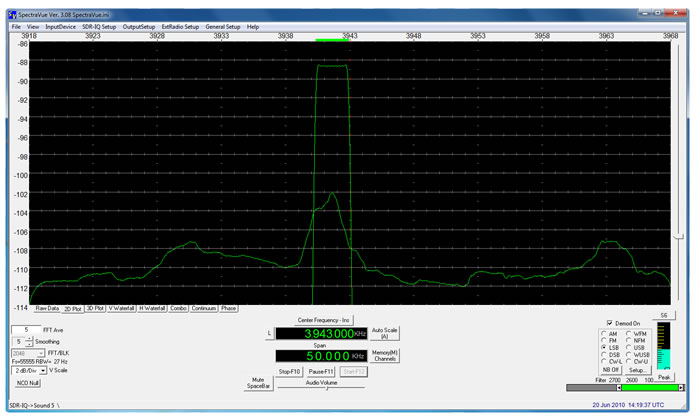
This is the SDR-IQ display using SpectraVue (ver. 3.08). It is only showing a 50 KHz-wide section of the band here, but it can show up to 190 KHz. It looks really great on a large screen. |
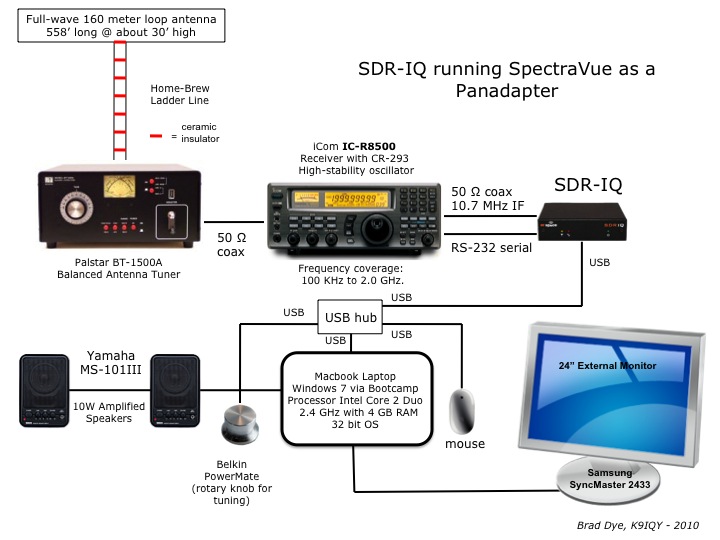
My other receiver set-up. This is great for monitoring 900 MHz paging signals. I can actually see the difference between 4-level and 2-level modulation. |

This is the block-diagram for the SDR-IQ from RFSpace.
Click here to e-mail Brad Dye, K9IQY k9iqy@braddye.com Back to the Paging Information Resource page or the K9IQY page. Dave Powis, G4HUP article about this project. You can read it here. |
|
|||||||||||||||||||||||||||||||||
| Precise Frequency Locking for the RFSpace SDR radios |
| Home Page | Directory | Consulting | Newsletters | Free Subscription | Products | Reference | Glossary | Send e-mail |